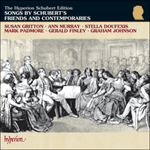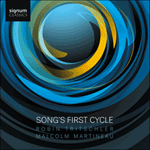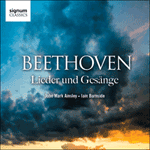
Welcome to Hyperion Records, a British classical label devoted to presenting high-quality recordings of music of all styles and from all periods from the twelfth century to the twenty-first.
Hyperion offers both CDs, and downloads in a number of formats. The site is also available in several languages.
Please use the dropdown buttons to set your preferred options, or use the checkbox to accept the defaults.

All six poems concern the feelings of love as translated through nature—or at least the kind of idealized countryside vistas that had already been immortalized in the ‘Pastoral’ Symphony. All are cast in strophic form except the last, but Beethoven constantly varies and develops his accompaniments. Although these musical changes are not entirely for poetic reasons, they nevertheless help create a sense of progressive musical architecture totally denied strict strophic form.
Beethoven’s poetic sensitivity extends to such lengths as Wo die Berge so blau being kept on an uncomplicated harmonic leash until the words ‘Innere Pein’. Similarly, the move to the tonic minor for the last three stanzas of Leichte Segler in den Höhen is a moment of profound musical insight.
The cycle is quite literally brought full circle by the final song, which recalls material from the first. This technique was to prove a profound influence on the song cycles of Robert Schumann, who also concealed a number of other musical references to An die ferne Geliebte in his work, including the Beethovenian Fantasy in C, Op 17.
from notes by Julian Haylock © 1999
Les six poèmes traitent des sentiments amoureux tels que traduits dans la nature—ou, du moins, du type de paysages de campagne idéalisés déjà immortalisés dans la Symphonie «Pastorale». Tous sont de forme strophique, hors le dernier, mais Beethoven n’a de cesse de varier et de développer ses accompagnements. Si ces changements musicaux ne sont pas entièrement dus à des raisons poétiques, ils n’en contribuent pas moins à créer une sensation d’architecture musicale progressive, totalement affranchie de la forme strophique stricte.
La sensibilité poétique de Beethoven est telle qu’elle tient Wo die Berge so blau en une laisse harmonique simple, jusqu’aux mots «Innere Pein». À l’identique, le passage au mineur de la tonique, pour les trois dernières strophes de Leichte Segler in den Höhen, est un moment d’une profonde perspicacité musicale.
Le cycle est littéralement bouclé par le dernier lied, qui reprend le matériau du premier. Cette technique devait profondément influencer les cycles de lieder de Robert Schumann, lequel dissimula également dans son œuvre un certain nombre d’autres références à An die ferne Geliebte (mais aussi à la Fantaisie en ut, op.17).
Beethoven ne mérite guère de figurer au pantheon des compositeurs de lieder (Schubert, Schumann, Brahms, Wolf), mais il montra constamment la voie aux autres—même si sa destinée musicale ultime fut ailleurs.
extrait des notes rédigées par Julian Haylock © 1999
Français: Hyperion Records Ltd
Alle sechs Gedichte beschreiben Liebesgefühle auf dem Umweg über Betrachtungen der Natur—oder zumindest jener idealisierten Landschaftsbilder, die Beethoven schon in der Sinfonie „Pastorale“ unsterblich gemacht hatte. Sie sind mit Ausnahme des letzten strophisch vertont, doch Beethoven variiert und entwickelt immer wieder die Begleitungen. Diese musikalischen Änderungen sind nicht unbedingt durch die dichterische Vorlage begründet, tragen aber dazu bei, jenes Gefühl eines fortschreitenden musikalischen Aufbaus zu erzeugen, das strenger strophischer Form ganz und gar verwehrt ist.
Beethovens dichterische Sensibilität geht soweit, daß Wo die Berge so blau bis zu den Worten „innere Pein“ an einer unkomplizierten harmonischen Leine gehalten wird. Entsprechend ist der Übergang in die Molltonikavariante für die Dauer der letzten drei Strophen von Leichte Segler in den Höhen ein Augenblick profunder musikalischer Einsicht.
Der Kreis wird durch das letzte Lied, das Material aus dem ersten in Erinnerung ruft, im wahrsten Sinn des Wortes geschlossen. Diese Methode sollte tiefgreifenden Einfluß auf die Liedzyklen von Robert Schumann ausüben, der in seinem Schaffen außerdem eine ganze Reihe musikalischer Verweise auf den Zyklus An die ferne Geliebte versteckt hat, so auch in der C-Dur-Fantasie op. 17 im Beethovenschen Stil.
Beethoven hat wohl kaum einen Platz in der vordersten Reihe der Liedkomponisten verdient—etwa neben Schubert, Schumann, Brahms oder Wolf. Immerhin aber hat er unbeirrbar anderen den Weg nach vorn gewiesen—selbst wenn sein eigener musikalischer Werdegang letztlich eine andere Richtung genommen hat.
aus dem Begleittext von Julian Haylock © 1999
Deutsch: Anne Steeb/Bernd Müller
 Schubert: The Complete Songs Schubert: The Complete Songs‘This would have been a massive project for even the biggest international label, but from a small independent … it is a miracle. An ideal Christ ... ‘Please give me the complete Hyperion Schubert songs set—all 40 discs—and, in the next life, I promise I'll "re-gift" it to Schubert himself … fo ...» More |
 Songs by Schubert's friends and contemporaries Songs by Schubert's friends and contemporaries‘This enterprising, often revelatory set should intrigue and delight anyone interested in the development of the Lied’ (Gramophone) ‘Since making music with friends was Schubert's whole raison d'etre, this 3-CD box is an inspired idea … led by the soprano Susan Gritton, ...» More |
 Song's first cycle Song's first cycleThe creation of the song cycle as an art form was paved with musical experiments and innovations. Robin Tritschler and Malcolm Martineau here chart the progress made by the great Lied composers of the day toward the cyclical perfection finally ach ...» More |
 Beethoven: Lieder und Gesänge Beethoven: Lieder und GesängeBeethoven was not a keen song writer, yet despite this almost half of his total works call for a voice. The present album includes some of the best of those compositions interpreted by accomplished tenor John Mark Ainsley and his accompanist Iain ...» More |

